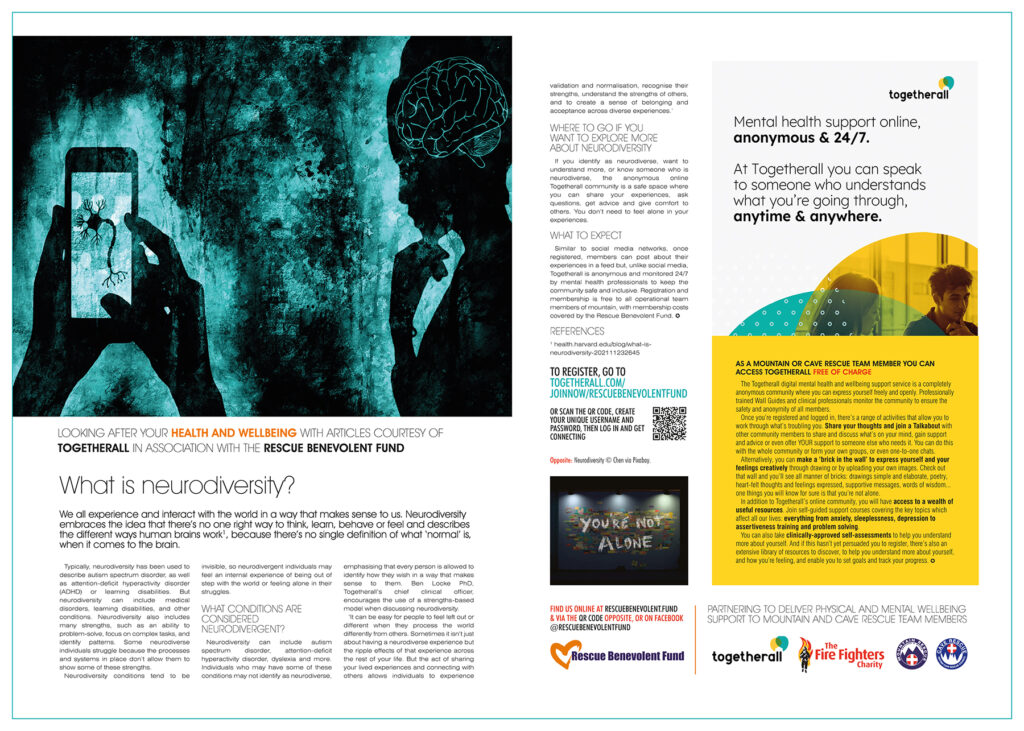What is neurodiversity?
We all experience and interact with the world in a way that makes sense to us. Neurodiversity embraces the idea that there’s no one right way to think, learn, behave or feel and no single definition of what ‘normal’ is, when it comes to the brain.
From the archive: Mountain Rescue Magazine Issue 85, Summer 2023. From Togetherall in association with the Rescue Benevolent Fund.

We all experience and interact with the world in a way that makes sense to us. Neurodiversity embraces the idea that there’s no one right way to think, learn, behave or feel and describes the different ways human brains work1, because there’s no single definition of what ‘normal’ is, when it comes to the brain.
Typically, neurodiversity has been used to describe autism spectrum disorder, as well as attention-deficit hyperactivity disorder (ADHD) or learning disabilities. But neurodiversity can include medical disorders, learning disabilities, and other conditions. Neurodiversity also includes many strengths, such as an ability to problem-solve, focus on complex tasks, and identify patterns. Some neurodiverse individuals struggle because the processes and systems in place don’t allow them to show some of these strengths.
Neurodiversity conditions tend to be invisible, so neurodivergent individuals may feel an internal experience of being out of step with the world or feeling alone in their struggles.

What conditions are considered neurodivergent?
Neurodiversity can include autism spectrum disorder, attention-deficit hyperactivity disorder, dyslexia and more. Individuals who may have some of these conditions may not identify as neurodiverse, emphasising that every person is allowed to identify how they wish in a way that makes sense to them. Ben Locke PhD, Togetherall’s chief clinical officer, encourages the use of a strengths-based model when discussing neurodiversity.
‘It can be easy for people to feel left out or different when they process the world differently from others. Sometimes it isn’t just about having a neurodiverse experience but the ripple effects of that experience across the rest of your life. But the act of sharing your lived experiences and connecting with others allows individuals to experience validation and normalisation, recognise their strengths, understand the strengths of others, and to create a sense of belonging and acceptance across diverse experiences.’
Where to go if you want to explore more about neurodiversity
If you identify as neurodiverse, want to understand more, or know someone who is neurodiverse, the anonymous online Togetherall community is a safe space where you can share your experiences, ask questions, get advice and give comfort to others. You don’t need to feel alone in your experiences.
What to expect
Similar to social media networks, once registered, members can post about their experiences in a feed but, unlike social media, Togetherall is anonymous and monitored 24/7 by mental health professionals to keep the community safe and inclusive. Registration and membership is free to all operational team members of mountain, with membership costs covered by the Rescue Benevolent Fund.
References: 1 health.harvard.edu/blog/what-is-neurodiversity-202111232645
Why not explore our growing collection of articles to support your health and wellbeing here?